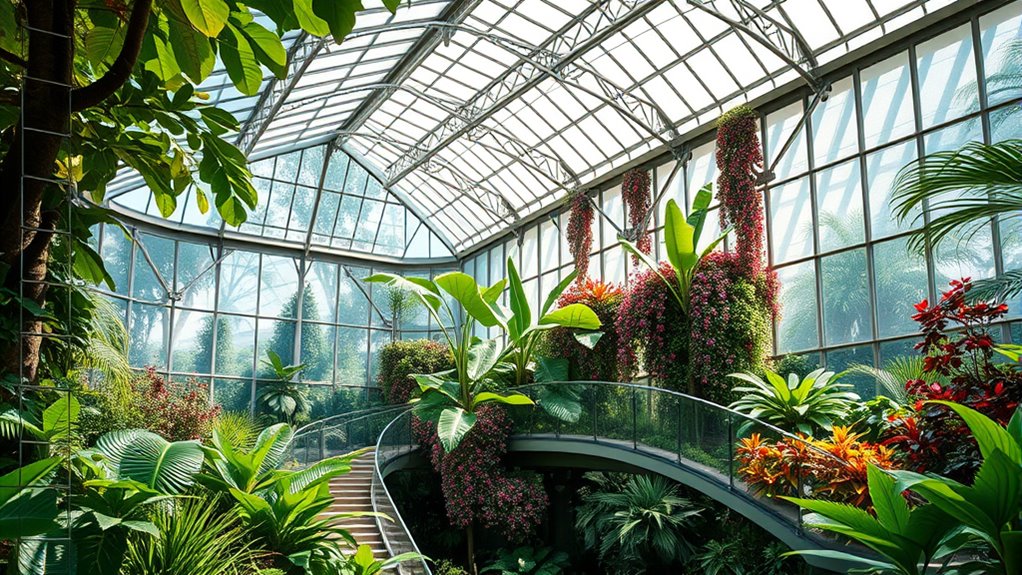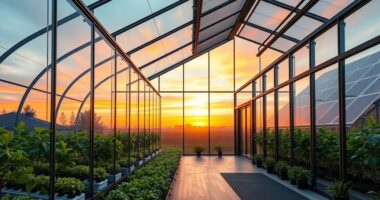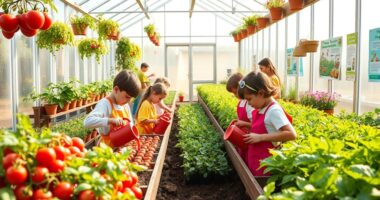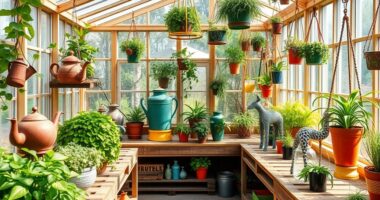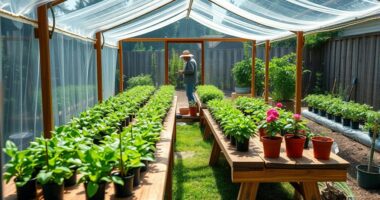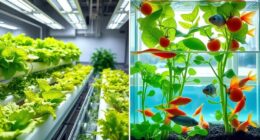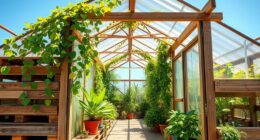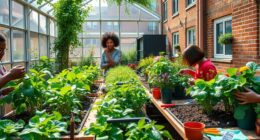Inspiring greenhouse designs worldwide showcase how using sustainable materials and climate-specific features can boost plant growth and energy efficiency. From Scandinavian structures built with locally sourced wood to Middle Eastern greenhouses using natural stones for temperature control, each design adapts to its environment. Innovations like automated shading, ventilation, and solar energy make these structures eco-friendly and resilient. Keep exploring, and you’ll discover more ideas to inspire your own greenhouse projects.
Key Takeaways
- Diverse climate-responsive features, such as natural ventilation and shading, optimize plant growth worldwide.
- Use of sustainable, locally sourced materials enhances environmental friendliness and structure durability.
- Innovative ventilation strategies, including large vents and automated systems, adapt to extreme weather conditions.
- Integration of renewable energy sources like solar panels improves greenhouse sustainability globally.
- Design adaptations tailored to regional climates demonstrate effective, resource-efficient greenhouse architecture.
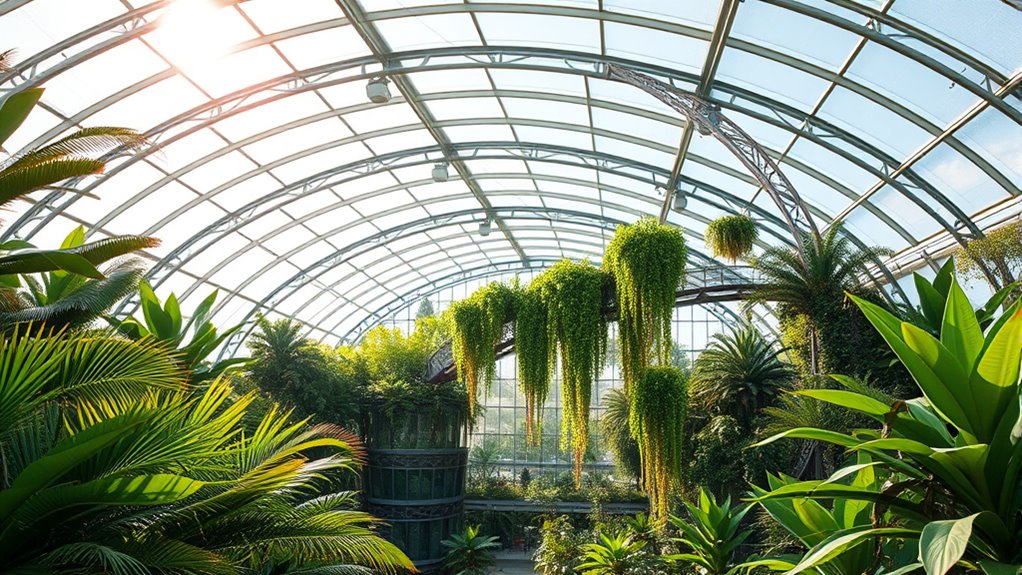
Have you ever wondered how different cultures adapt greenhouse designs to their unique climates and needs? It’s fascinating to see how various regions innovate to create efficient, sustainable, and culturally resonant structures. One of the key aspects that shape these designs is the use of sustainable materials, which not only reduce environmental impact but also enhance the greenhouse’s ability to blend with its surroundings. For instance, in Scandinavian countries, greenhouses often incorporate locally sourced wood and recycled materials, emphasizing eco-friendliness and durability. Meanwhile, in warmer climates like the Middle East, structures might use natural stones or clay to keep temperatures down, ensuring plants thrive without excessive energy expenditure.
Another essential feature that varies widely across regions is ventilation. Innovative ventilation systems are indispensable for maintaining ideal conditions inside greenhouses, especially in areas with extreme weather. In Japan, for example, greenhouses often incorporate automated shading and cross-ventilation techniques that respond dynamically to temperature and humidity changes. These systems help regulate heat and moisture, reducing the need for artificial cooling and promoting healthier plant growth. Similarly, in Mediterranean countries, traditional greenhouses emphasize natural air circulation—large vents and open sides that maximize airflow during hot days, minimizing reliance on energy-intensive fans and air conditioning. These ventilation strategies reflect a deep understanding of local climates, making the structures more sustainable and adaptable.
Innovative ventilation adapts to climate, from Japan’s automated systems to Mediterranean natural airflow, enhancing sustainability and plant health.
Across the globe, designers and farmers continuously experiment with new materials and ventilation methods to improve efficiency. In South America, some greenhouses utilize lightweight, transparent plastics that filter sunlight while insulating plants from the intense heat. This approach reduces energy consumption and fosters a more sustainable environment. Meanwhile, in colder regions like Canada or Russia, greenhouses often employ innovative insulation techniques combined with geothermal heating, reducing reliance on fossil fuels. Ventilation here focuses on managing cold air while preventing frost damage, which requires carefully engineered systems that balance airflow and insulation. Additionally, incorporating renewable energy sources like solar panels can further enhance the sustainability of these structures.
Ultimately, these diverse greenhouse designs from around the world demonstrate that understanding local climate conditions is essential for creating effective structures. Whether it’s using sustainable materials or implementing innovative ventilation, each design reflects a tailored approach that maximizes efficiency, sustainability, and plant health. By studying these international examples, you can gain insights into how adaptable and resourceful greenhouse architecture can be, inspiring your own efforts to develop environmentally friendly and climate-conscious growing spaces.
Frequently Asked Questions
What Sustainable Materials Are Best for Eco-Friendly Greenhouses?
You should consider using recycled plastics for your eco-friendly greenhouse, as they reduce waste and are durable. Bamboo frameworks are another excellent choice because they’re fast-growing, renewable, and strong. Combining recycled plastics with bamboo creates a sustainable structure that minimizes environmental impact while providing excellent insulation and support. These materials are both eco-conscious and effective, helping you build a greenhouse that’s good for the planet and perfect for your gardening needs.
How Do Climate Differences Influence Greenhouse Design Choices?
Climate differences heavily influence your greenhouse design choices. You need to focus on climate adaptation by customizing your design to suit local conditions, like insulation in cold regions or shading in hot areas. This means selecting materials, ventilation, and heating systems that work best for your environment. By tailoring your greenhouse’s design, you guarantee ideal plant growth and energy efficiency, regardless of climate variations.
What Innovative Technologies Are Used in Modern Greenhouse Construction?
You incorporate innovative technologies like solar panels to harness renewable energy, reducing operational costs and environmental impact. Automated ventilation systems optimize airflow and temperature control, ensuring plants stay healthy regardless of external weather conditions. These advancements make modern greenhouses more efficient and sustainable, allowing you to grow crops year-round. By integrating solar panels and automated ventilation, you enhance productivity while minimizing energy consumption, creating a smarter, eco-friendly greenhouse environment.
How Can Greenhouses Be Integrated Into Urban Environments Effectively?
Urban greenhouses are the heartbeat of city sustainability, shining like jewels in the skyline. You can integrate them through vertical farming and rooftop gardens, turning unused spaces into lush, productive environments. These green havens not only improve air quality but also provide fresh produce right at your doorstep. By designing adaptable, visually appealing structures, you make sustainable growth a seamless part of city life, helping the city breathe and thrive.
What Are the Cost Considerations for Building International Greenhouse Styles?
When building international greenhouse styles, you should start with a thorough cost analysis to understand expenses like materials, labor, and permits. Budget planning helps you prioritize features and avoid unexpected costs. Keep in mind that unique designs or advanced climate controls may increase costs. By comparing options and planning carefully, you can make certain your project stays within budget while achieving your desired greenhouse style effectively.
Conclusion
As you explore these innovative greenhouse designs, remember that they’re like modern-day greenhouses of Eden—bringing nature’s beauty and sustainability into our lives. Just as the Tower of Babel aimed for greatness, these structures push boundaries, inspiring you to think creatively about nurturing growth. Let these global examples ignite your passion for eco-friendly innovation, reminding you that, like nature itself, great ideas flourish when nurtured with imagination and purpose.
